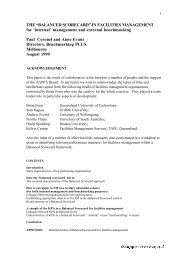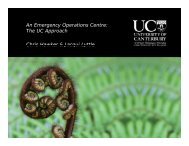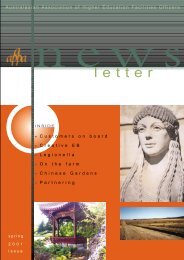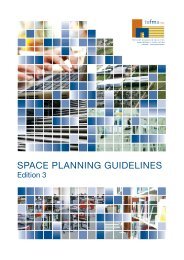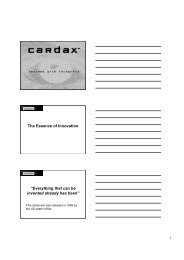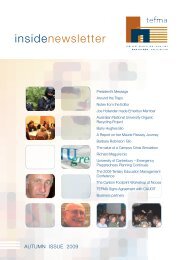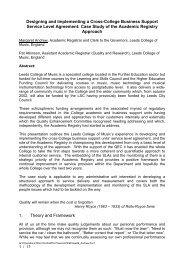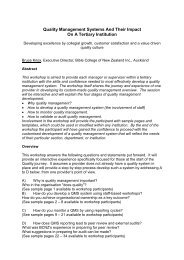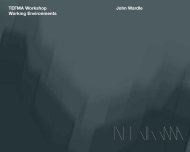aappa history - Tertiary Education Facilities Management Association
aappa history - Tertiary Education Facilities Management Association
aappa history - Tertiary Education Facilities Management Association
Create successful ePaper yourself
Turn your PDF publications into a flip-book with our unique Google optimized e-Paper software.
20 AAPPA HISTORY<br />
Need for a professional association…<br />
It was obvious that a professional approach was needed. The genesis of<br />
AAPPA occurred in the early 1970s, when a number of Buildings Officers<br />
in Australia became interested in exchanging information and<br />
experience. They realised that they had much to learn from each other.<br />
Initially this exchange began by visiting other campuses for discussions,<br />
followed by the establishment of small informal groups and then larger<br />
gatherings (for example, the NSW Buildings Group.) Contact was being<br />
made at this time with colleagues in New Zealand.<br />
It was soon realised that the breadth of experience and information<br />
needed was unavailable in Australia but there were opportunities in the<br />
much larger North American systems. People such as Bill Humble<br />
(University of Queensland), Alan Cole (Griffith University), Ted Dews<br />
(James Cook University), Geoff Harrison (Flinders University), Maurie<br />
Pawsey (University of Melbourne), and Denis Stephenson (La Trobe<br />
University), became members of APPA (<strong>Association</strong> of Physical Plant<br />
Administrators), and/or SCUP (Society for College and University<br />
Planning) and began to attend their annual meetings.<br />
There were serious challenges at this time for Australia’s Buildings<br />
Officers, whose responsibilities covered all aspects of physical planning,<br />
capital development and facilities management. The question to be<br />
addressed was whether APPA, SCUP, or perhaps NACUBO (Business<br />
Officers’ <strong>Association</strong>) would be the most appropriate contact or focus<br />
for Australian practitioners. The then (and in some cases current) North<br />
American practice of separating Planning/Space <strong>Management</strong>/<br />
Construction into a Planning and Construction Office, away from the<br />
operational arm of Maintenance/Custodial/Grounds/Security/Traffic<br />
Office based on their State/Institutional funding sources was strange to<br />
Australians and New Zealanders. In many cases it still is.<br />
APPA or SCUP?…<br />
Australian visitors began to achieve recognition among their American<br />
peers by presenting technical papers at the US annual meetings.<br />
Correspondence also began to flow between our contacts in North<br />
America, and some Australians had articles published in US professional<br />
journals. By the late 1970s/early 1980s, Australians, represented by Bill<br />
Humble, Maurie Pawsey and Geoff Harrison, began to receive invitations<br />
to be members of APPA and SCUP Committees – usually the International<br />
Committee. On these they continued to lobby for both organisations to<br />
recognise their international opportunities and obligations.<br />
Around the end of the 1970s and into the 1980s, SCUP suffered a decline<br />
in membership, its influence and then a financial decline. APPA, however,<br />
continued to grow and widen its influence. To Australians, it appeared to<br />
be the organisation to support. In more recent years, SCUP has made a<br />
‘comeback’, and Australians have again been involved in both organisations.<br />
Throughout the 1980s, we in Australia made a strong effort to ensure<br />
that Australian universities were represented at every annual APPA<br />
conference, and at SCUP conferences whenever possible. It also became<br />
essential to remind APPA regularly of our presence by contributing<br />
papers. Strategies to bring our existence to the attention of members<br />
were many and varied. A slide showing Australia superimposed on<br />
mainland USA was a telling graphic of Australia’s existence and size.<br />
In the late 1980s Bill Humble and Maurie Pawsey became members of<br />
the APPA International Committee. However, before recording the next<br />
stages of the move into the North American scene, we need to look at<br />
developments in Australasia at this time.<br />
AAPPA HISTORY 21




